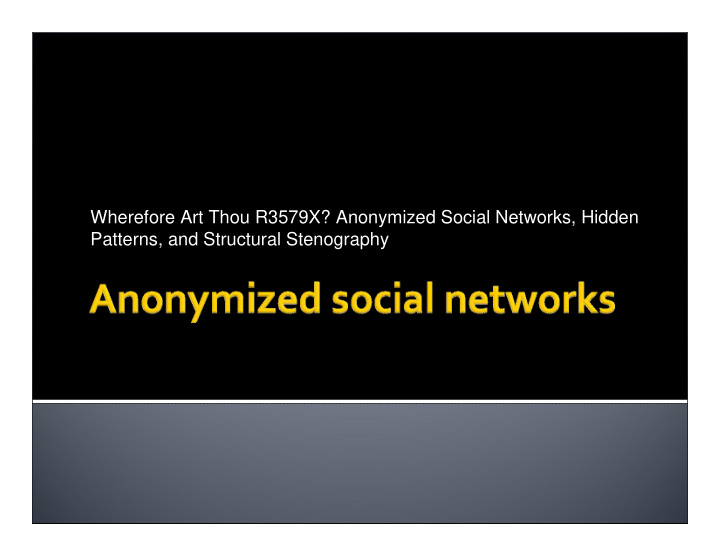



Wherefore Art Thou R3579X? Anonymized Social Networks, Hidden Patterns, and Structural Stenography
� A social network occurs anywhere there is social interaction between people. � Examples include Email, instant messaging, Facebook, blogging trackbacks, coauthor networks
� The structure of social networks can be interesting How are friendships usually structured? Are there hubs, such as Heather, who connect separate networks? How many degrees of Kevin Bacon? We can investigate these questions if we have the data to mine.
� For our examples, we will use a network of emails sent between users. John Mary Vertex Directed edge Vertex � How do we protect users’ privacy while still releasing the data for research?
� Remove any identifiable information, such as name and other attributes. � Randomly rename the vertices R3579X R73313
� Convert directed edges to undirected edges. This increases the complexity and makes it harder to attack. R3579X R73313 Undirected edge
� Let’s say you want to know if two vertices are connected on the graph. � All the identifying info has been removed, so how do we do it?
� An active attack involves the adversary creating vertices in the graph before the graph is released � The adversary will create edges between the vertices in a fashion that it can then recognize later on in when the graph is released
� We create k new vertices around 2*(log n) where n is the total number of vertices � We create new d o – d 1 edges between these new vertices and the other ones in the graph � Then, we randomly create edges between these new nodes with independent probability of 1/2
� Given the graph, how do we find the subgraph that we created? � Create a search tree, pruning the tree based on the properties of our subgraph, such as the number of degrees of our new vertices
Mary John Tom Mike Zoe
Mary John Tom k2 k1 k3 k5 k4 Mike Zoe
Mary John Tom k2 k1 k3 k5 k4 Mike Zoe
Mary John Tom k2 k1 k3 k5 k4 Mike Zoe
QWER ZXCV JKL UYT WER HGF DFG ASD ASDF BNM
QWER ZXCV JKL k2 k1 k3 k5 k4 ASDF BNM
Mary John JKL k2 k1 k3 k5 k4 ASDF BNM
� The paper proves that the search tree does not grow too large and that the algorithm displays good performance � Also, it proves that the subgraph is unique so that we don’t identify the wrong subgraph
� They simulate an attack on LiveJournal friendship links. They create the accounts on the website, make the connections, and then crawl the site and anonymize the data � The network has 4.4 million nodes and 77 million edges
� Only needs sqrt(log(n)) new nodes to attack the graph � However, it’s much more computationally intensive and less practical in the real world, although it takes less nodes
� It’s a lot like an active attack, except you don’t create new nodes, instead you collaborate with your friends and find yourselves in the graph � However, because you did not specifically target certain people, you may not be able to identify other people when you find yourself
� We cannot rely on anonymization to ensure privacy in social networks � Possible improvements: add noise to the data by adding/removing random edges
Recommend
More recommend